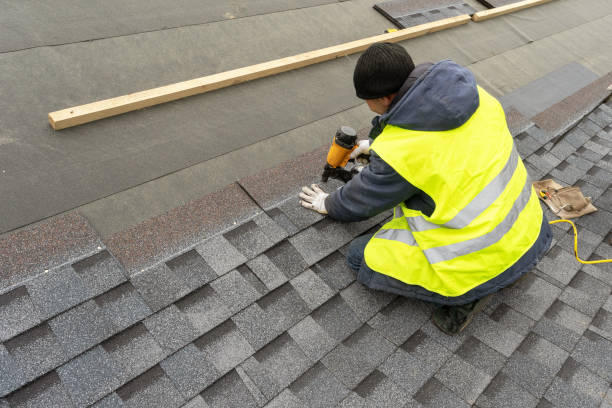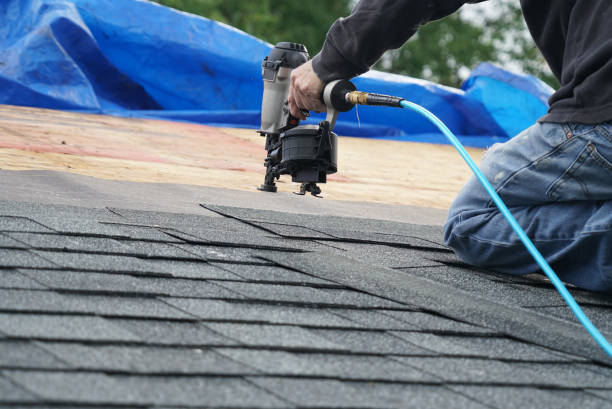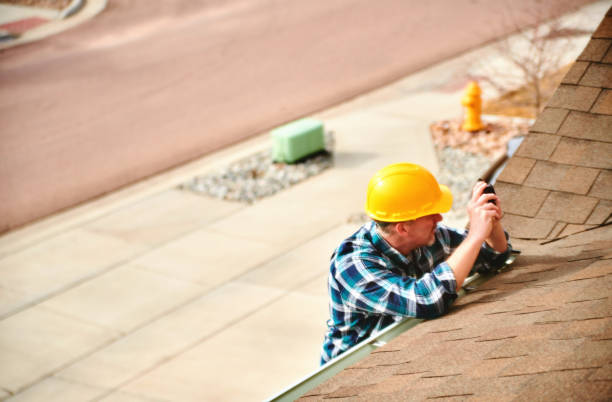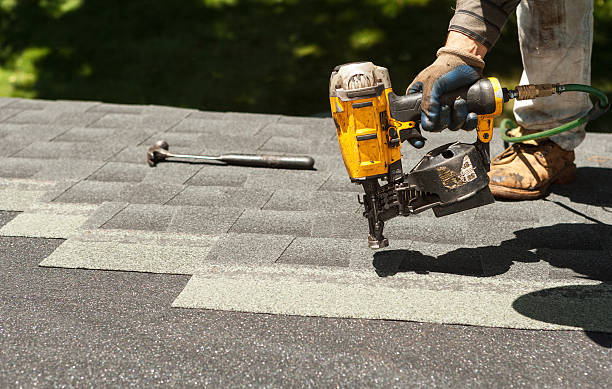Tips from a Minneapolis Roofer for a Seamless Roof Replacement

When it’s time for a roof replacement, taking the proper steps to prepare your home can make the process smoother and reduce potential disruptions. A well-prepared home ensures that both you and your roofing contractor can focus on completing the project efficiently and safely. Here are some practical tips to get started.
Organize Outdoor Areas
- Clear Driveways and Pathways: Remove vehicles from driveways or parking spaces near your house to give roofers easy access for unloading materials.
- Relocate Outdoor Furniture: Move outdoor furniture, grills, potted plants, or decorative items away from areas near your roof. This prevents them from being damaged by falling shingles or debris.
- Cover Landscaping: Use tarps or drop cloths to protect flower beds, shrubs, and other landscaping features close to the house.
Secure Indoor Spaces
Roofing work can cause vibrations throughout your home, which may affect fragile items inside. Taking precautions inside is equally as important as securing outdoor spaces.
- Remove Wall Decorations: Take down any artwork, mirrors, shelves, or other items hanging on walls that could shift due to vibrations.
- Secure Fragile Items: Store delicate belongings like glassware or ceramics in cabinets with padding if possible.
- Cover Items in Attics: If you have storage in your attic directly beneath the roof being replaced, cover these belongings with plastic sheeting or tarps to protect them from dust and debris.
Communicate with Your Roofer
- Discuss timelines and ask for an estimated duration of the project.
- Clarify where dumpsters or materials will be placed during the process.
- Address any concerns about specific areas of your property that require extra care.
Providing these details ensures everyone is on the same page for a smooth workflow.
Preparing Pets and Family Members
- Arrange alternative accommodations for pets if they are sensitive to noise.
- Notify family members about potential disruptions so they can plan their day accordingly.
| Task | Action Required | Importance |
| Clear driveways | Remove vehicles from work zones | High |
| Protect landscaping | Cover shrubs/plants with tarps | Moderate |
| Secure wall decorations | Take down fragile wall-mounted objects | High |
| Cover attic belongings | Use plastic sheets to prevent dust accumulation | Moderate |
Taking time to prepare thoroughly not only protects your property but also allows roofing professionals to focus solely on delivering high-quality results without unnecessary distractions.
Steps to Take Before Your Minneapolis MN Roofing Contractor Arrives for Roof Installation
Proper preparation is key to ensuring a smooth and stress-free roof replacement project. Taking the right steps before your roofer arrives can help protect your property, reduce potential delays, and foster efficient communication with your contractor. Below are essential actions homeowners should take to prepare their home and surroundings for a roofing project.
Clear Your Driveway and Outdoor Areas
Roofing materials and equipment require space for unloading, staging, and work. For this reason, it’s important to clear your driveway and outdoor areas ahead of time.
- Move vehicles: Park cars in the garage or away from the property to avoid potential damage from falling debris or dust.
- Relocate outdoor furniture: Move patio chairs, tables, grills, planters, and other outdoor items away from the house or into storage.
- Secure children’s toys: Collect bicycles, skateboards, or other play equipment near work zones to maintain safety.
By clearing these spaces, you provide roofers easier access while reducing the risk of accidental damage.
Prepare Attic Spaces
- Cover stored items with plastic sheeting or tarps to protect them from dust accumulation.
- Consider relocating delicate objects temporarily to safer parts of the house.
- Secure loose insulation materials if necessary.
A prepared attic ensures belongings remain clean and undamaged throughout the project duration.
Trim Trees and Landscaping
- Trim low-hanging branches near the roofline.
- Consult professionals if large trees require extensive pruning.
- Ensure shrubs are pruned back from walls for improved clearance.
Efforts like these not only assist contractors but also minimize cleanup requirements later.
Coordinate with Neighbors
Suggestions involving neighbor discussions involve; Giving notices advanced
Essential Steps to Prepare for Your Minneapolis MN Roofing Contractor Before Roof Installation
Preparing your home ahead of time for a roof installation can make the process more efficient, safer, and less stressful for both you and the roofing crew. By taking proactive measures, you can ensure that the project proceeds smoothly with minimal disruptions to your household. Here are some essential steps to follow before your roofer arrives.
1. Clear Your Driveway and Surrounding Areas
Roofers will need easy access to their equipment, materials, and tools during installation. To facilitate this process:
– Park your vehicles away from the driveway or garage during the project timeline.
– Remove outdoor furniture, grills, or any movable items near the house’s perimeter to prevent damage from falling debris or accidental contact with tools.
– Store bicycles, garden tools, toys, and other objects in a secure indoor space.
This ensures there’s enough room for work trucks and reduces any risks of damage to your belongings.
2. Inform Your Neighbors About the Project
Roof replacement can be noisy and disruptive at times. It’s a considerate gesture to let your neighbors know when the work will take place, so they can plan accordingly:
– Provide them with approximate start and end dates for the project.
– If possible, share contact information for the roofing company in case they have any concerns about noise or debris on shared property lines.
Good communication fosters understanding and minimizes potential conflicts.
3. Secure Fragile Indoor Items
Vibrations from roofing work may cause fragile items inside your home to shift or fall:
– Remove delicate wall art, mirrors, or fixtures from walls directly beneath the roofing area.
– Secure loose decorative pieces on shelves like glass vases or ceramics by wrapping them in bubble wrap or storing them temporarily in cabinets.
This extra precaution helps protect valuable items from unintended damage.
4. Protect Your Indoor Spaces
Dust and debris may enter your home during installation through attic spaces or ventilation systems:
– Cover furniture in rooms directly below roofing activities using plastic sheets or drop cloths.
– Close doors leading to attics or storage spaces that might be affected by falling dust particles.
These steps help maintain cleanliness inside while work is ongoing.
5. Prep Outdoor Plants and Landscaping Features
Roofing projects often involve debris removal which could pose risks to plants around your home:
| Task | Action | |—————————|———————————————————————-| | Cover shrubs/flower beds | Use tarps or lightweight netting for protection against falling shingles/debris. | | Relocate potted plants | Move pots to a safe distance from areas of activity temporarily | | Trim overhanging branches | Helps provide ease-of-access & reduces interference above rooflines |
Properly protecting landscaping not only safeguards its beauty but also gives workers clearer access while minimizing accidental damage risks.
6. Discuss Safety Protocols with Children & Pets
To avoid accidents or injuries:
– Establish restricted zones where children should not play during active hours on-site. – Create a quiet area indoors where pets can feel safe away from noise disturbances.
Keeping loved ones out of harm’s way ensures safety while adding peace-of-mind throughout renovations.
Taking these preparatory actions before work begins creates an environment that’s organized both indoors/outdoors ensuring smoother coordination between homeowners professionals alike
Tips for Protecting Indoor Items During a Minneapolis MN Roof Replacement
When preparing for a roof replacement, many homeowners focus on the exterior of their home. However, the interior deserves just as much attention, especially when it comes to safeguarding fragile and valuable items. Roof replacement involves heavy tools, vibrations, and consistent movement in and around your home, which can impact sensitive indoor belongings. Taking a few proactive measures will help ensure that your items remain secure during the roofing process.
1. Identify Fragile and Valuable Items
- Frames or artwork hanging on walls
- Glass decorations or figurines
- Mirrors and other breakable wall-mounted items
- Electronics like televisions, computers, or sound systems
- Fragile furniture pieces with glass components (e.g., coffee tables)
Once identified, create a checklist of these items so you don’t miss anything.
2. Remove Wall-Mounted Decor
- Take down mirrors, picture frames, clocks, and other hanging objects from walls near the roofline.
- Store these items securely in padded boxes or wrap them in bubble wrap for extra protection.
For larger pieces like mounted TVs or oversized framed art, consider storing them temporarily in rooms farthest from where roofing work will occur.
3. Protect Delicate Furniture
- Cover upholstered furniture with plastic sheeting or drop cloths to prevent dust accumulation.
- Relocate glass-topped tables or other delicate furniture pieces away from areas under heavy roofing work.
- Use foam padding on sharp edges of furniture that may accidentally get bumped by workers moving equipment inside your home.
4. Secure Light Fixtures
- Tighten any loose fittings before roofing begins.
- If possible, remove lightweight fixtures temporarily and store them safely.
- For larger fixtures that cannot be removed easily, consider covering them with protective material like thick fabric or bubble wrap.
5. Protect Nearby Rooms From Dust
| Area | Protection Strategy |
| Attic Access Points | Seal with plastic sheeting taped securely around edges |
| HVAC Vents | Cover vents with magnetic covers or tape plastic sheets over them temporarily |
| Floors | Lay down tarps across floors near entryways used by workers |
This additional layer of protection keeps indoor areas cleaner while preventing dust from infiltrating sensitive spaces.
6. Communicate With Your Roofer
- Let the roofer know if specific areas contain fragile belongings so they can take extra care when working nearby.
- Discuss whether workers might need attic access; if so, prepare this space accordingly by removing stored valuables ahead of time.
By following these steps carefully prior to roof replacement day, you’ll not only protect delicate indoor items but also reduce stress throughout the process knowing everything is properly safeguarded.
Essential Tips for Minneapolis MN Roof Repair and Ensuring a Smooth Replacement Day
A roof replacement is a significant home improvement project, and ensuring that the process goes smoothly requires careful planning and preparation. By following these essential tips, you can help minimize disruptions, protect your property, and streamline the work for your roofing contractor.
Confirm All Details Beforehand
- Verify the Schedule: Double-check the date and time of the roof replacement with your contractor to avoid any scheduling conflicts.
- Understand the Scope of Work: Review the contract details, including materials being used, warranties, and expected timelines.
- Weather Considerations: Keep an eye on weather forecasts leading up to the replacement day. If inclement weather is expected, discuss contingency plans with your roofer.
Clear Your Driveway and Access Points
Roofers need easy access to their tools, equipment, and materials. Clearing pathways will help them work efficiently: – Move vehicles out of the driveway to provide space for trucks or dumpsters. – Remove bicycles, toys, or other items near access points or areas surrounding your home.
Protect Fragile Indoor Items
The vibrations caused by roofing work can sometimes affect decor or fragile items inside your home: – Remove wall hangings such as picture frames or mirrors in rooms directly beneath the roof. – Secure valuable or delicate items on shelves to prevent them from falling.
Communicate Any Special Concerns
Every property is unique. If you have specific concerns about landscaping or structural sensitivities: – Inform your roofer of areas that need special attention (e.g., outdoor plants or delicate garden arrangements). – Discuss existing issues like weak attic beams so they can take extra precautions during installation.
Ensure Safety for Family Members and Pets
Roof replacement involves noise and potential hazards: – Keep children and pets indoors during active work hours to ensure their safety. – Consider arranging alternative accommodations if you anticipate significant disturbances that may impact daily routines.
Essential Steps for a Successful Minneapolis MN Roof Installation Day
| Task | Status | Notes |
| Clear driveway and outdoor spaces | ✅ Pending | Provide space for equipment |
| Remove fragile indoor items | ✅ Pending | Focus on rooms directly below the roof |
| Notify family members about noise | ✅ Pending | Plan activities away from home if needed |
| Confirm with roofer one day prior | ✅ Pending | Verify arrival time |
Stay Available but Minimize Disruptions
While it’s vital to be accessible in case contractors have questions: – Avoid interrupting their workflow unnecessarily. – Designate a point of contact (yourself or another household member) who can communicate updates or decisions with ease.
Follow Up After Work Wraps Up
Once roofing has been completed: 1. Walk around your property to check for debris cleanup. 2. Ask contractors if there are specific post-installation care instructions. 3. Inspect initial results with them to ensure satisfaction before departing.
By taking these steps on replacement day, you’ll not only reduce stress but also contribute positively toward a successful roofing project.
Key Actions to Take After Your Roof Replacement is Complete
1. Conduct a Thorough Inspection
- Walk around your home: Check for leftover materials like nails, shingles, or debris in your yard or driveway.
- Look inside and outside: Examine areas where the roof meets walls, vents, and chimneys to ensure proper sealing.
- Inspect the gutters: Roofing debris can sometimes clog gutters during construction. Make sure they’re clear and functioning properly.
If you notice any issues or areas of concern during your inspection, communicate these immediately with your roofer. Most roofing contractors offer warranties and will address identified problems promptly.
2. Understand Your Warranty
| Type of Warranty | Coverage | Duration |
| Manufacturer’s Warranty | Covers defects in roofing materials | Can range from 10-50 years |
| Workmanship Warranty | Covers errors made during installation | Typically 1-10 years |
Keep all warranty documentation in a safe place for future reference.
3. Maintain Regular Cleaning and Maintenance
- Trim trees regularly: Overhanging branches can damage shingles or cause debris buildup.
- Clean gutters seasonally: Prevent water backup by removing leaves or dirt that collects over time.
- Monitor for moss or algae growth: Inspect for discoloration or streaks, especially in shaded areas of the roof.
Be proactive with maintenance tasks to extend the lifespan of your new investment.
4. Set Up a Routine Inspection Schedule
- Every 6 months (spring and fall) for routine maintenance.
- After severe weather events such as hailstorms or heavy winds.
A professional inspection can catch minor issues before they escalate into costly repairs.
5. Update Your Homeowner’s Insurance Policy
- Inform them about the new installation as it may qualify you for discounts on premiums.
- Provide all necessary documentation such as invoices, contractor details, and warranty information for records.
Updating your policy ensures you’re fully covered in case of future weather-related damages.
6. Communicate with Your Roofer Regarding Future Needs
Many roofing companies offer ongoing maintenance programs or discounted inspections for returning clients. Building a long-term relationship with your roofer ensures quick responses if future repairs or maintenance are needed.
By taking these steps after replacing your roof, you not only secure peace of mind but also maximize the lifespan and performance of one of the most critical elements protecting your home.
The Importance of Clear Communication with Your Roofer
Effective communication between you and your roofing contractor is critical to ensuring a successful roof replacement project. Misunderstandings or a lack of clarity can lead to delays, unexpected costs, or dissatisfaction with the final result. Here are key aspects of clear communication to help you establish a productive relationship with your roofer.
Discuss Details of the Roofing Project
- Materials: Ensure you understand the type, quality, and warranty details for the materials being used.
- Timeline: Clarify when the work will begin, expected completion dates, and potential causes of delays (e.g., weather conditions).
- Cost Breakdown: Request an itemized estimate that includes labor, materials, permits, and additional fees.
This discussion should provide a shared understanding between you and your roofer regarding expectations.
Put Everything in Writing
| Key Contract Elements | Description |
| Scope of Work | Detailed explanation of what tasks will be performed |
| Payment Schedule | Breakdown of payment terms (e.g., deposit amount and final payment) |
| Warranties | Information on product warranties and workmanship guarantees |
| Insurance Details | Proof that the roofer carries liability insurance |
A well-documented contract protects both parties by minimizing disputes later on.
Establish Open Lines of Communication
- Designate a Point Person: Identify one person responsible for coordinating discussions on each side.
- Set Regular Check-Ins: Schedule periodic updates during long or complex installations.
- Use Technology: Texts or emails can document details like adjustments or approvals while keeping records for reference.
Encourage your roofer to be transparent about progress and any unforeseen changes during installation.
Ask Questions Early On
- Are there alternative options for roofing materials within my budget?
- How will debris removal be handled?
- Will weather conditions affect my roof installation?
By clarifying uncertainties early on, you’ll avoid unnecessary stress later in the process.
Address Issues Promptly
If problems arise—such as scheduling conflicts or concerns about workmanship—it’s crucial to bring them up immediately rather than waiting until after completion. A proactive approach ensures that issues can be resolved efficiently without derailing the overall project.
Benefits of Clear Communication
- Fewer misunderstandings about expectations
- Increased trust between homeowner and contractor
- Higher likelihood of finishing on time and within budget
- Greater satisfaction with final results
Being proactive in maintaining open dialogue ensures that both you and your roofer are aligned every step of the way.
Comprehensive Resources for Homeowners Considering Roof Replacement
Roof replacement is a significant investment that requires careful planning and informed decision-making. To help homeowners navigate this process, it’s important to have access to comprehensive resources that address every aspect of roof replacement. This guide provides actionable advice, tools, and references to ensure your roofing project is successful and stress-free.
Understanding Your Roofing Options
- Affordable and widely used.
- Lifespan: 20–30 years.
- Variety of colors and styles available.
- Durable and energy-efficient.
- Lifespan: 40–70 years.
- Resistant to harsh weather conditions.
- Ideal for hot climates due to thermal properties.
- Lifespan: Up to 100 years with proper maintenance.
- Offers a natural aesthetic; eco-friendly option when sourced sustainably.
- Lifespan: Approximately 30 years (dependent on maintenance).
When selecting materials, consider factors such as climate, budget, maintenance requirements, aesthetics, and long-term performance.
Choosing the Right Roofing Contractor
- Credentials Verification: Ensure contractors are licensed, insured, and bonded in your state.
- Experience Review: Look for companies with extensive experience in residential roofing.
- References & Reviews: Request customer references or check online reviews on platforms like Angi or the Better Business Bureau.
- Written Estimates: Obtain detailed quotes from at least three contractors for price comparison.
- Warranty Coverage: Confirm what warranties are offered for both labor and materials.
A professional contractor should provide clear communication throughout the process, from timelines to potential challenges.
Cost Estimation Table
| Roofing Material | Average Cost (per sq ft) | Maintenance Costs | Lifespan |
| Asphalt Shingles | $3–$5 | Low | 20–30 years |
| Metal Roofing | $6–$12 | Low | 40–70 years |
| Clay/Concrete Tiles | $10–$25 | Moderate | Up to 100 years |
| Wood Shakes/Shingles | $7–$10 | High | ~30 years |
Costs can vary depending on location, complexity of installation, and material brand.
Preparing Your Home for Roof Replacement
- Protect Interior Spaces: Remove fragile items from walls or shelves that might be affected by vibrations.
- Outdoor Preparations: Cover outdoor furniture or move valuables away from work zones.
- Address Accessibility Issues: Clear driveways or pathways so equipment can be easily transported.
Taking these steps helps mitigate damage risks during construction work.
Post-Replacement Maintenance Tips
- Schedule routine inspections (once every year) to identify potential issues early.
- Keep gutters clean to prevent water pooling or damage.
- Trim overhanging tree branches that could scratch shingles during storms.
Proper maintenance ensures you maximize your investment over time while keeping repair costs minimal.
This comprehensive approach equips homeowners with the information they need when considering a roof replacement project—helping them take informed actions at every stage of their journey toward a better-protected home.
- A Comprehensive Guide to Choosing the Right Minneapolis MN Roofing Contractor for Homeowners
- Tips from a Minneapolis Roofer for a Seamless Roof Replacement
- 8 Hidden Benefits of a Minneapolis MN Roof Replacement for Your Home
- When to Call a Minneapolis Roofer to Replace Your Roof
- A Comprehensive Guide to Choosing the Right Minneapolis MN Roofing Contractor for Your Roof Installation
- The 4-Step Process of Replacing Your Roof With a Minneapolis MN Roofing Contractor





